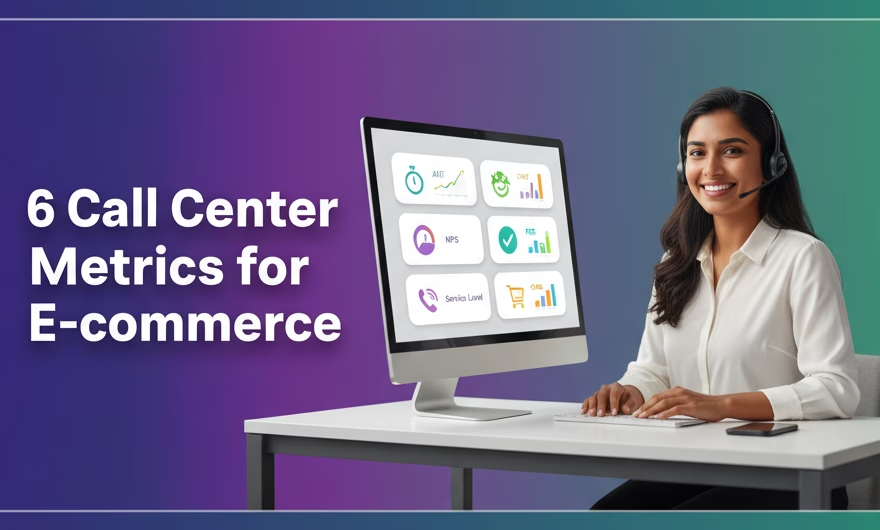Managing an e-commerce business requires focusing on the right call center metrics to ensure an excellent customer experience and a sustainable competitive advantage. With customer journeys spanning search, checkout, delivery, returns, and loyalty, these metrics help you identify friction, allocate resources effectively, and scale service quality reliably. Below are six critical metrics to monitor and optimize.
1. Cost of Customer Acquisition (CAC)
What it is: CAC reflects the total cost involved in acquiring a new customer over a defined period. It typically includes marketing, advertising, sales team expenses, creative/production, tools, and relevant overheads.
Why it matters for e-commerce: Rising media costs, seasonal campaigns, and discount-driven conversions can inflate CAC. For call centers, high CAC increases the stakes on every customer interaction—turning first-time buyers into repeat customers is essential to recoup acquisition spend.
How to calculate:
- CAC = (Total Sales + Marketing Costs over a period) ÷ (Number of New Customers in the same period)
Tips to improve:
- Route high-intent inquiries (e.g., product availability, delivery windows) to the best-fit agents to boost conversion at the point of contact.
- Leverage proactive communication (order updates, back-in-stock alerts) to reduce uncertainty and prevent abandonment.
- Use call disposition and CRM tags to identify campaigns that generate high-quality customers (low returns, strong repeat behavior) and reallocate budget accordingly.
- Track payback period alongside CAC to ensure unit economics remain healthy during peak seasons.
2. Average Handle Time (AHT)
What it is: AHT measures the average time taken by an agent to complete an interaction, including talk time, hold time, and after-call work (ACW)—in other words, the Average Handle Time.
Why it matters for e-commerce: E-commerce queries are often time-sensitive (order status, address changes, cancellations). Optimizing AHT improves speed and capacity while protecting service quality.
How to calculate:
- AHT = (Total Talk Time + Total Hold Time + Total After-Call Work) ÷ Total Number of Calls
How to use it wisely:
- Track AHT by contact type (refunds, order tracking, tech support). Complex interactions should have higher, acceptable AHT bands.
- Automate repeatable steps—address validation, return labels, OTP verification—to reduce handle time without rushing customers.
- Provide unified agent desktops with order history, delivery status, and policy snippets to minimize toggling and ACW.
- Coach for “first-time right” answers. Shorter isn’t always better if it leads to repeat contacts.
3. Customer Satisfaction Score (CSAT)
What it is: CSAT gauges how satisfied customers are with the service they received. It’s commonly measured with a post-interaction survey using a 1–5 or 1–10 scale.
Why it matters for e-commerce: Service quality directly influences repeat purchases, return rates, and reviews. Fast, empathetic resolutions turn one-time buyers into loyal customers.
How to calculate:
- CSAT = (Number of “Satisfied” responses ÷ Total Survey Responses) × 100%
Best practices:
- Send surveys immediately after resolution on the same channel (voice, chat, email) for higher response quality.
- Segment CSAT by reason code, product category, and courier partner to identify targeted improvements.
- Act on verbatim feedback. Use text analytics to surface themes like packaging issues, delivery delays, or unclear policies.
- Close the loop with detractors quickly to prevent churn and salvage the relationship.
4. Net Promoter Score (NPS)
What it is: NPS (Net Promoter Score) measures customer loyalty by asking how likely they are to recommend the business to others on a 0–10 scale. Responses are categorized as Promoters (9–10), Passives (7–8), and Detractors (0–6). NPS is calculated by subtracting the percentage of Detractors from the percentage of Promoters.
Why it matters for e-commerce: In a market where price and product can be matched quickly, loyalty and advocacy differentiate brands. NPS connects service quality to long-term growth.
How to calculate:
- NPS = % Promoters − % Detractors
Ways to improve NPS through the call center:
- Measure at key journey points: post-delivery, post-return/refund, and after service escalations.
- Empower agents with targeted save-offers or policy flexibility for high-value or at-risk customers.
- Combine NPS with reason codes to pinpoint the drivers of detractor sentiment (e.g., delivery delays vs. product quality) and feed fixes to the right teams.
- Recognize and replicate promoter-making behaviors: proactive updates, clear timelines, and sincere ownership.
5. First Call Resolution (FCR)
What it is: FCR (First Call Resolution) tracks the percentage of customer issues resolved in the first contact without the need for follow-ups or callbacks.
Why it matters for e-commerce: Higher FCR reduces operational costs, eases queue pressure during spikes, and meaningfully boosts satisfaction—especially for urgent queries like address changes or cancellation requests.
How to calculate:
- FCR = (Issues Resolved on First Contact ÷ Total Issues) × 100%
How to raise FCR:
- Give agents real-time access to order management, inventory, courier tracking, and refund tools to resolve without handoffs.
- Create guided workflows for common journeys (returns, replacements, exchanges) to standardize “first-time right.”
- Use callback promises sparingly; if needed, define tight SLAs and notify customers proactively.
- Identify and fix upstream causes of repeat contacts (ambiguous policies, missing emails/SMS, app glitches).
6. Service Level
What it is: Service level is the percentage of calls answered within a predefined time threshold (for example, answering within X seconds). It reflects the responsiveness and availability of the call center.
Why it matters for e-commerce: During sales, holidays, or product drops, demand can spike abruptly. Consistent service levels protect customer trust when it matters most.
How to calculate:
- Service Level = (Calls Answered within Threshold ÷ Total Calls Offered) × 100%
How to manage and improve:
- Forecast using historical patterns for promotions, new launches, and courier blackout dates; build scenarios for best and worst cases.
- Use intraday management: flex shifts, cross-skill agents, and enable short-term surge staffing during peaks.
- Offer smart deflection where appropriate: IVR self-service for order status, WhatsApp/SMS tracking links, and callback options during high wait times.
- Monitor real-time dashboards for queue health, abandonment, and agent occupancy to react before SLAs slip.
Understanding Service Level Fluctuations
Service level fluctuations may be caused by high call volumes, service outages, agent absenteeism, or upstream issues like courier disruptions and payment failures. To prevent customer dissatisfaction:
- Set automated alerts when queues breach thresholds and trigger contingency playbooks (priority routing, callbacks, or temporary policy relaxations).
- Align with operations and logistics teams on promotions, inventory constraints, and delivery exceptions to anticipate spikes.
- Publish timely, consistent updates across IVR, website banners, and order tracking pages to reduce avoidable calls.
- Run post-incident reviews to update forecasts, staffing models, and customer messaging templates.
Bringing the Metrics Together
Tracking these metrics in isolation can create trade-offs. The goal is balanced performance:
- AHT vs. FCR/CSAT: Reducing AHT aggressively can hurt FCR and CSAT. Establish acceptable AHT bands by interaction type and coach for quality first.
- CAC vs. NPS/CSAT: If acquisition relies on heavy discounts, ensure service and fulfillment maintain the experience promised in ads; otherwise churn rises and CAC payback suffers.
- Service Level vs. Cost: Extremely high service levels can be expensive. Use channel mix, self-service, and intelligent routing to meet customer expectations efficiently.
- FCR as a lever: Improving FCR often lifts CSAT/NPS and reduces repeat contacts, lowering staffing pressure and cost per contact.
Measurement and Governance Essentials
To ensure these metrics drive real improvement in an e-commerce environment:
- Define clear formulas and apply them consistently across teams and channels (voice, chat, email, messaging apps).
- Segment reporting by product category, order stage, customer tier, and region to surface actionable insights.
- Instrument the journey with reason codes, disposition tags, and integration to order and logistics systems.
- Close the loop through weekly reviews that tie metric movement to coaching, process changes, and policy updates.
- Embed QA with calibrated scorecards focused on empathy, accuracy, and policy adherence.
- Invest in agent enablement—knowledge bases, guided workflows, and real-time assistance—to improve quality without increasing handle time.
Conclusion
These six metrics—CAC, AHT, CSAT, NPS, FCR, and Service Level—form the backbone of an e-commerce call center’s performance strategy. Measured consistently, analyzed by journey stage, and acted upon through coaching and process improvements, they help you balance speed, quality, and cost. By aligning teams around these indicators and refining them through seasonality and promotional cycles, e-commerce businesses can deliver responsive, reliable service that builds trust, fuels repeat purchases, and sustains growth. Which call center metrics does your organization prioritize to stay competitive?




